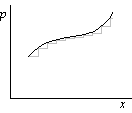Weak shocks are shocks across which the differences in
velocity, pressure, and density are all very small. We can then
approximate as
![]() ,
, ![]() ,
, ![]() ,
, ![]() , etcetera.
, etcetera.
Starting with (3'), it becomes:
![]()
This is the justification why some computational schemes for transsonic flow ignore the irreversibility effects. But note that this can be tricky. If you raise the velocity of a sphere in an inviscid fluid enough to create a small supersonic pocket around it, the total pressure loss of the fluid going through the shock is enough to prevent it from reaching the rear symmetry plane. That would not be correctly seen in a computation in which irreversibility is ignored.
Our other equation, (2') is even more interesting for weak shocks. It becomes:
![]()
Now, looking again at the picture, u1 is the velocity of the shock compared to the fluid entering the shock:


In fact, not only weak shocks, but also other weak disturbances in a gas move with the speed of sound. That is because a disturbance (or ``wave'') can be approximated as a lot of small shocks; for example, this is shown for the pressure profile below:

That closes the observations about weak shocks. Back to finite strength ones. We now want to complete the solution process.